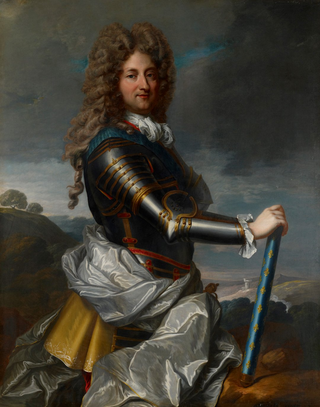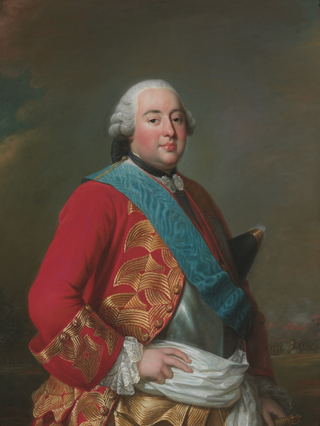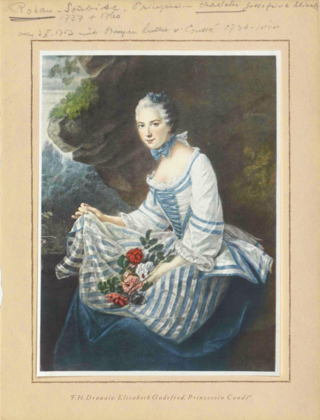Related Research Articles

The House of Bourbon is a dynasty that originated in the Kingdom of France as a branch of the Capetian dynasty, the royal House of France. Bourbon kings first ruled France and Navarre in the 16th century. A branch descended from the French Bourbons came to rule Spain in the 18th century and is the current Spanish royal family. Further branches, descended from the Spanish Bourbons, held thrones in Naples, Sicily, and Parma. Today, Spain and Luxembourg have monarchs of the House of Bourbon. The royal Bourbons originated in 1272, when Robert, the youngest son of King Louis IX of France, married the heiress of the lordship of Bourbon. The house continued for three centuries as a cadet branch, serving as nobles under the direct Capetian and Valois kings.

Louis XV, known as Louis the Beloved, was King of France from 1 September 1715 until his death in 1774. He succeeded his great-grandfather Louis XIV at the age of five. Until he reached maturity in 1723, the kingdom was ruled by his grand-uncle Philippe II, Duke of Orléans, as Regent of France. Cardinal Fleury was chief minister from 1726 until his death in 1743, at which time the king took sole control of the kingdom.

Philippe II, Duke of Orléans, was a French prince, soldier, and statesman who served as Regent of the Kingdom of France from 1715 to 1723. He is referred to in French as le Régent. He was the son of Monsieur Philippe I, Duke of Orleans, and Madame Elisabeth Charlotte, Duchess of Orléans. Born at his father's palace at Saint-Cloud, he was known from birth by the title of Duke of Chartres.

Louis Philippe I, Duke of Orléans, known as le Gros, was a French royal of a cadet branch of the House of Bourbon. The First Prince of the Blood after 1752, he was the most senior male at the French court after the immediate royal family. He was the father of Philippe Égalité. He greatly augmented the already huge wealth of the House of Orléans.

Louis, Duke of Orléans was a member of the House of Bourbon, and as such was a prince du sang. At his father's death, he became the First Prince of the Blood and Duke of Orléans. Known as Louis le Pieux and also as Louis le Génovéfain, Louis was a pious, charitable and cultured prince, who took very little part in the politics of the time.

Louis Marie Jacques Amalric, comte de Narbonne-Lara was a French nobleman, soldier and diplomat.

The 4th House of Orléans, sometimes called the House of Bourbon-Orléans to distinguish it, is the fourth holder of a surname previously used by several branches of the Royal House of France, all descended in the legitimate male line from the dynasty's founder, Hugh Capet. The house was founded by Philippe I, Duke of Orléans, younger son of Louis XIII and younger brother of Louis XIV, the "Sun King".

Marie-Louise O'Murphy, also variously called Mademoiselle de Morphy, La Belle Morphise, Louise Morfi or Marie-Louise Morphy de Boisfailly, was the youngest lesser mistress of King Louis XV of France, and the model for François Boucher's painting The Blonde Odalisque, also known as The Resting Girl.

Charles de Rohan, 4th Prince of Soubise, Prince of Soubise, Duke of Rohan-Rohan, Seigneur of Roberval, and Marshal of France from 1758, was a soldier, and minister to kings Louis XV and Louis XVI. He was the last male of his branch of the House of Rohan, and was great-grandfather to the Duke of Enghien, executed by Napoleon in 1804. Styled Prince d'Epinoy at birth, he became the Prince of Soubise after 1749.

Louise Marie Adélaïde de Bourbon, Duchess of Orléans, was the daughter of Louis Jean Marie de Bourbon, Duke of Penthièvre and Princess Maria Teresa d'Este. At the death of her brother, Louis Alexandre, Prince of Lamballe, she became the wealthiest heiress in France prior to the French Revolution. She married Louis Philippe II, Duke of Orléans, the "regicide" Philippe Égalité, and was the mother of France's last king, Louis Philippe I. She was sister-in-law to Marie Thérèse Louise, Princess of Lamballe, and was the last member of the Bourbon-Penthièvre family.

Françoise Marie de Bourbon was the youngest illegitimate daughter of King Louis XIV of France and his maîtresse-en-titre, Françoise-Athénaïs de Rochechouart, Marquise de Montespan. At the age of 14, she married her first cousin Philippe d'Orléans, the future regent of France during the minority of Louis XV. Through two of her eight children, she became the ancestress of several of Europe's Roman Catholic monarchs of the 19th and 20th centuries—notably those of Belgium, Italy, Portugal, Spain, and France.

Marie Victoire Sophie de Noailles, Countess of Toulouse, was a French noble and courtier. Her second spouse was Louis Alexandre de Bourbon, Count of Toulouse, the youngest legitimized son of King Louis XIV of France and his maîtresse-en-titre, Madame de Montespan.

Charlotte de Rohan was a French aristocrat who married into the House of Condé, a cadet branch of the ruling House of Bourbon, during the Ancien Régime. She was Princess of Condé by her marriage. She has no known descendants today as her grandson, heir to the Condé family, died without children and her daughter remained childless. Charlotte was praised for being a cultured and attractive princess of her age.
René-Louis Chartier de Lotbinière (1641–1709) was a French-Canadian Poet, 1st Seigneur de Lotbinière in New France (1672), Judge of the Provost and Admiralty Courts and Chief Councillor of the Sovereign Council of New France.

A royal bastard is a child of a reigning monarch born out of wedlock. The king might have a child with a mistress, or the legitimacy of a marriage might be questioned for reasons concerning succession.

Louis Charles Antoine de Beaufranchet, Comte de Beaufranchet d'Ayat, Seigneur d'Ayat, de Beaumont, de Saint-Hilaire, etc. was a French general and politician under the French First Republic and French First Empire. He was the son of Marie-Louise O'Murphy and Jacques de Beaufranchet.

The Blonde Odalisque, or Resting Girl, are two oil-on-canvas paintings by the French painter François Boucher. The paintings feature a naked woman on her stomach on a couch. The first was made in 1751, whilst the second was made in 1752, although both were made by Boucher. The nude figure is thought to be Marie-Louise O'Murphy, one of the many mistresses of King Louis XV of France, who was only 14-15 years old when the painting was made. The paintings fall into the odalisque genre.

Marie Geneviève Radix de Sainte-Foy was a French noblewoman as the mistress to King Louis XV of France, as well as to Louis, Dauphin of France in 1750–51. She was the king's Petite maîtresse, not his Maîtresse-en-titre.
Marie Brigitte O'Murphy (1729–1793), was a mistress to Louis XV of France from 1755 to 1757. She was the king's Petite maîtresse, not his Maîtresse-en-titre.
References
- ↑ Connaissez-vous ces auvergnats célèbres ? 1750-1850, Georges-Léonard Hémeret, Editions Créer (1990) p.168